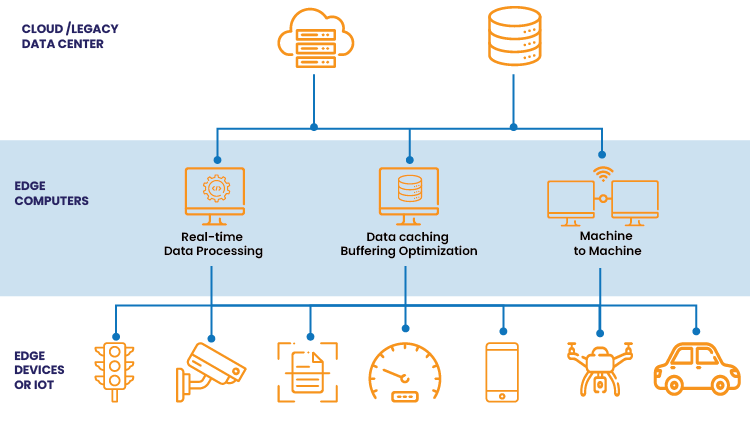

ACL Digital
Transforming the Digital Landscape with Edge Computing and IoT
In an era where high-speed internet enables seamless access to data stored across vast networks, the future of technology is evolving through Edge Computing (EC). EC enables data processing to be closer to user devices, instead of relying solely on centralized cloud servers, which directly enhances speed and efficiency. This shift, coined “edge” computing due to its proximity to user hardware, is revolutionizing global data access and utilization.
The market for edge computing, valued at $11.7 billion in 2022 and projected to soar to $45.4 billion by 2028, is predominantly driven by the rapid adoption of Internet of Things (IoT) solutions. As EC continues to gain momentum, its impact on technology and connectivity promises to reshape digital landscapes worldwide.
This article explores the mechanics of Edge Computing (EC) and its potential applications for diverse industries.
How Edge Computing Works?
Edge computing transforms the way data is processed and analyzed by bringing these functions closer to where data is generated. Here’s a step-by-step explanation of how edge computing works:
Data Generation at the Network Edge
Data is captured by internet-connected devices like sensors, cameras, smartphones, and IoT devices at the intersection of the physical and digital worlds.
Local Processing
Data is processed locally on the devices themselves or on nearby edge servers, instead of being sent to a distant central location.

Building Edge Networks
IT teams set up servers and storage units at remote locations within the same geographical area to rapidly process data close to its source.
Reduction of Latency
Local data processing minimizes latency, crucial for real-time applications, by ensuring quicker response times and timely data insights.
Data Filtering and Local Storage
Most data is processed and stored locally, with only essential information sent to the cloud or central data centers, reducing bandwidth strain and long-distance data travel.
Enhanced Security
Local processing keeps sensitive information within a local perimeter, reducing the risk of data breaches during transmission over insecure networks.
Key Benefits of Edge Computing in IOT
Edge computing provides a range of transformative advantages by bringing computational capabilities closer to where data is generated. Here are some of the crucial areas where edge computing has a significant impact:
Real-time Latency Reduction
Edge computing optimizes IoT applications by enabling data processing near devices, which decreases latency for real-time responses. For instance, it can swiftly adjust lighting levels based on room occupancy detected by sensors, improving energy efficiency without delays caused by distant data centers.
Optimizing Bandwidth Usage
IoT devices send small data packets to centralized clouds for analytics, which works well now but could strain networks as device numbers grow. Edge computing filters data near devices, reducing bandwidth use by sending only necessary data for storage or analysis to centralized platforms.
Enhancing IoT Security
Managing IoT security is a growing concern as device connections increase. Malware can exploit IoT devices for DDoS attacks. While edge computing isn’t inherently more secure than private clouds, its local proximity offers benefits. Companies worried about data storage and privacy laws can find security advantages with edge computing, especially if servers are on-site, ensuring data stays within their control and local jurisdiction.
How to Overcome Security Challenges with Edge Computing and IoT?
- Implement robust data encryption protocols to secure data in transit and at rest.
- Deploy intrusion detection and prevention systems (IDS/IPS) to monitor and mitigate threats at the edge.
- Utilize secure boot mechanisms to verify the integrity of firmware and software before execution.
- Implement strong access control measures to restrict unauthorized access to edge devices.
- Regularly update and patch edge devices and software to mitigate vulnerabilities.
- Employ multi-factor authentication (MFA) for accessing edge devices and systems.
- Implement network segmentation to isolate critical systems and data from potential breaches.
- Monitor and audit edge devices and systems continuously for anomalies and suspicious activities.
Impact of Edge Computing Across Industries
The power of advanced connectivity and real-time data processing is being utilized by numerous industries to revolutionize their operations:
Manufacturing
The manufacturing industry utilizes IoT for monitoring machines and automating production lines. With edge computing, real-time data analysis of manufacturing processes is possible, resulting in increased efficiency, reduced downtime, and improved quality control.
Transportation
IoT devices keep updated on traffic conditions, vehicle performance, wheel and fleet management and road safety in real-time. When Edge Computing handles this data, it amps up traffic management, cuts down on jams, and makes our roads safer. Plus, it lets us control traffic lights smartly and predict when our vehicles need maintenance.
Healthcare
Wearable devices and medical IoT solutions connected to IoT networks are responsible for collecting essential patient data. Edge Computing is able to quickly process this information, leading to faster health assessments and medical interventions. In telemedicine and remote patient monitoring, where immediate responses are crucial to saving lives, this technology has been particularly transformative.
Retail
The use of IoT is being utilized by retailers to gain insights into customer behavior, preferences, stock levels, and in-store conditions. Retailers can offer personalized shopping experiences, efficient inventory tracking and management, and dynamic pricing strategies due to the acceleration of analysis of this data through Edge Computing.
Conclusion
Edge Computing is transforming industries by bringing data processing closer to its source, enhancing speed, efficiency, and security. This technology drives smarter solutions, improves safety, and enriches user experiences across manufacturing, transportation, healthcare, and retail. By enabling real-time data analysis, reducing latency, optimizing bandwidth usage, and strengthening security, Edge Computing represents a significant leap forward in digital innovation. Businesses need to address security issues as the market expands due to the proliferation of IoT devices, to fully benefit from this transformative technology and create smarter operations and a more connected world.
Get to know our success stories and feel free to contact ACL Digital. Send us a message at business@acldigital.com.
Related Insights


